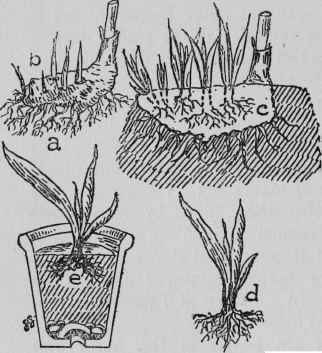February - First And Second Weeks. Flowers
Description
This section is from the book "The Garden Week By Week Throughout The Year", by Walter P. Wright. Also available from Amazon: The Garden Week by Week Throughout the Year.
February - First And Second Weeks. Flowers
We must continue our work of soil preparation this month, and endeavour to complete all big alterations or additions, such as making borders, rockeries, lawns, paths, arches, pergolas, and fruit trellises.

From a Water Colour Drawing by D. A. Rowe.
Flower Beds and Borders at Campsea Ashe, Suffolk. The Mauve Flower in the Front is Verbena venosa.
Verbenas
In the mid-Victorian epoch the Verbena was one of the pets of professional florists, and it suffered the common fate of being pampered and coddled, and cross-fertilised and over-propagated until it became a weakling, ever ready to fall a prey to a fungus - in this case mildew. So it fell under a cloud. But, sweet and pretty flower that it is, it was never forgotten, and it is now having a little revival. If the reader decides to indulge himself in a bed of mixed seedlings this year, he is not at all likely to regret it. I advise him to sow in a warm greenhouse early this month, set his plants out three inches apart in boxes when they begin to crowd, and harden them in a frame. There is an old species of Verbena called Venosa with a very uncommon colour, almost reminding one of mauve silk. I know of a bed of it in a Suffolk garden where, toned by the shadows of venerable Yews, it presents a refined and soothing contrast to the flames of Begonias and Zonal Geraniums. And memory recalls a charming group of this Verbena aud white Marguerites in a garden at Taormina. This Verbena may be raised from seed.
Hollyhocks
There are people in the world who never forget old flowers. It is not always that they are old themselves; they are often moved by an impulse of inherited floricultural loyalty - of all examples of fidelity the most precious. I know people who lament that the golden day of the Hollyhock has passed, merely from the recollection of the joy which their parents took in it in the years gone by. This grand old flower is never likely to regain the position which it once held in our gardens, because the fungoid enemy (doubtless brought on by false forcing culture) which laid it low is still lurking in the borders; but it is not to be despised as a seedling plant. The principal seedsmen sell well-selected strains, and the plants have better constitutions than those raised from cuttings. Besides, the plants are so cheap compared with named varieties that if the worst comes to the worst the loss is not severely felt. By sowing now in a warm house, and preventing delicacy of plant by thin culture, abundance of air, early potting, and hardening in a frame, a supply of vigorous plants can be secured that may be expected to bloom the same year.
The Gay Canna
This brilliant plant, handsome alike in its leaves and in its flowers, has been marvellously developed by florists, and one can but hope that they will not impart to it, by vegetative reproduction and forcing culture, a delicacy of constitution that may render it an easy prey to disease. Seminal reproduction, or the raising of plants by the most natural of all processes - sowing seed, may be expected to act as a safeguard. It is true that we cannot be sure of getting the special named varieties which are exhibited by florists quite true to type from seed, but that is only a calamity from the point of view of the specialist; it does not attain to the dimensions of a national disaster, such as is caused by the complete collapse of a great flower.

Fig. 25. - Propagating Cannas. a. Old tuber with young suckers growing at b.
c. Old tuber covered with compost.
d. A rooted sucker. e. How to pot the sucker.
The seeds of Cannas are as large as Peas, round, smooth, and extremely hard. The excessive induration has given them the name of "Indian Shot," and it militates against rapid germination. The process may be hastened by soaking the seeds in water for a night before sowing, and also by giving them a bottom heat of 650 to 700. The latter would tend to make the plants tender, but there is no difficulty in hardening them, as standing them in an unheated frame for two or three weeks before planting them out will serve that purpose. By sowing early in February, plants can be had in bloom in the garden the same year. The flowers are as brilliant as Gladioli, and in rich, deep, moist soil the foliage is of great beauty. Plants may be increased by suckers also (see Fig. 25).
Continue to:


